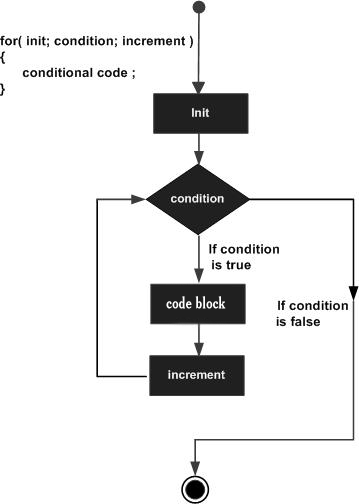What is For Loops in C Programming ?
In C programming, a for loop is a way to repeat a block of code for a certain number of times or until a certain condition is met. It has three parts:
- Initialization: In this part, you can declare and initialize any variables that will be used in the loop.
- Condition: In this part, you specify a condition that determines whether the loop should continue executing or not. The loop will keep running as long as the condition is true.
- Increment/Decrement: In this part, you can specify how the loop counter variable will be updated after each iteration of the loop. This is usually done by incrementing or decrementing the counter.
The syntax for a for loop in C programming looks like this:
for (initialization; condition; increment/decrement) {
// Code to be executed repeatedly
}
With a for loop, you can easily iterate over an array, process data, or perform any repetitive task efficiently and with ease.
Flow Chart Of For Loop

Example Of For Loops in C Programming
#include <stdio.h>
int main() {
int i; // declare a variable for the loop counter
for (i = 1; i <= 10; i++) {
printf("%d\n", i); // print the value of i
}
return 0;
}
In this example, the for loop consists of three parts:
- Initialization: We declare a variable
ito use as the loop counter. - Condition: We set the condition for the loop to continue:
imust be less than or equal to 10. - Increment/Decrement: We increment
iby 1 after each iteration of the loop.
The loop body simply prints the value of i using the printf() function. The loop runs 10 times, printing the numbers from 1 to 10 on separate lines.
Output
1
2
3
4
5
6
7
8
9
10
Frequently Asked Questions
In C, a for loop is a control flow statement that is used for iterative execution of a block of code. It is a type of loop construct that is commonly used when the number of iterations is known in advance. The for loop has three components:
- Initialization
- Condition
- Increment/Decrement
Nested loops in C are loops that are placed inside other loops. They can be useful in situations where you need to perform a repetitive task on a set of data that is organized in a hierarchical or multidimensional structure.
- Processing Two-Dimensional Arrays
- Working with Matrices
- Searching and Sorting
- Output Formatting
The for loop is a commonly used construct in C for iterating over arrays. When used with arrays, the for loop allows you to perform a repetitive task on each element of the array.
- Accessing Array Elements
- Calculating Array Statistics
- Sorting Arrays
- Searching Arrays
for (initialization; condition; increment/decrement) {
// code to be executed repeatedly
}
A nested for loop is a for loop that is placed inside another for loop. It is used when you need to iterate over a two-dimensional array or perform a repetitive task that requires two levels of iteration. Here is an example of a nested for loop that prints a multiplication table:
for (int i = 1; i <= 10; i++) {
for (int j = 1; j <= 10; j++) {
printf("%d x %d = %d\n", i, j, i*j);
}
}
Learn Web Development
 How to Get Started with Deepseek: A Step-by-Step Guide for Beginners
How to Get Started with Deepseek: A Step-by-Step Guide for Beginners- 1The Future of Deepseek: Trends and Predictions for 2024 and Beyond
- 2Top 10 Use Cases of Deepseek for Businesses and Individuals
- 3Deepseek vs. Competitors: Why It Stands Out in the Market in 2025
- 4How Deepseek is Revolutionizing [Industry/Field]: Key Insights in 2025
- 5What is Deepseek? A Comprehensive Guide to Its Features and Benefits 2025


